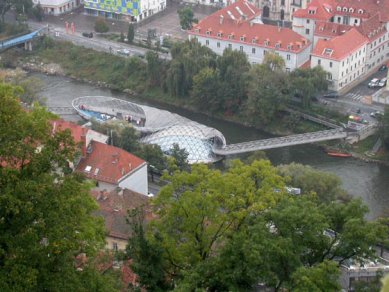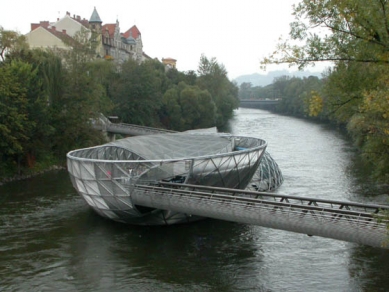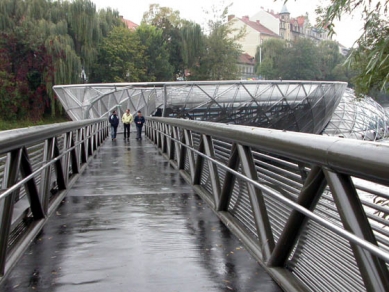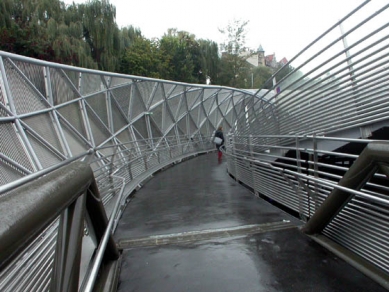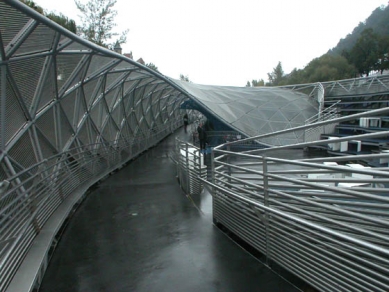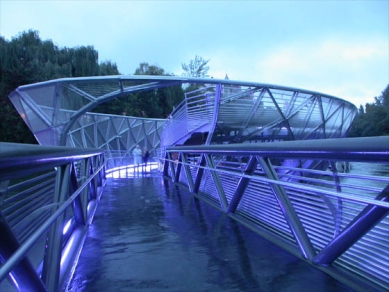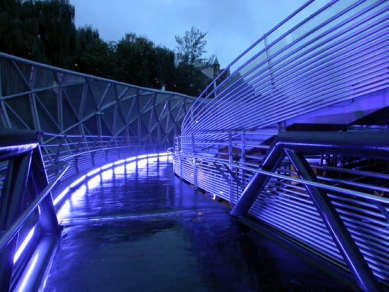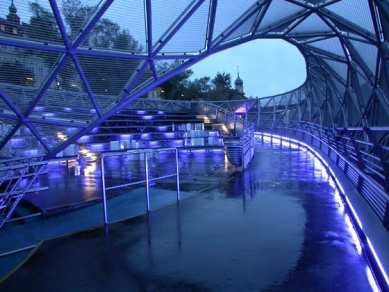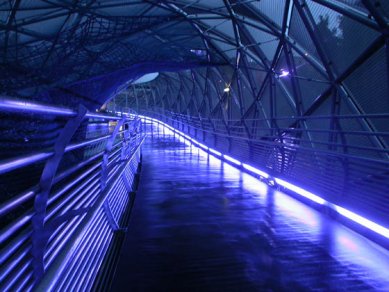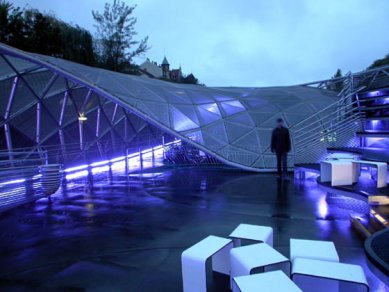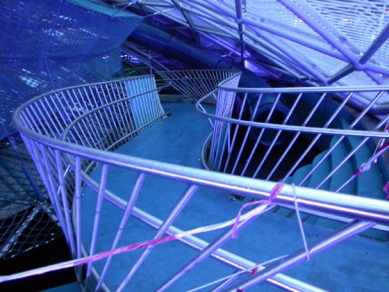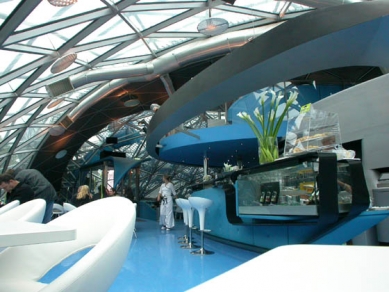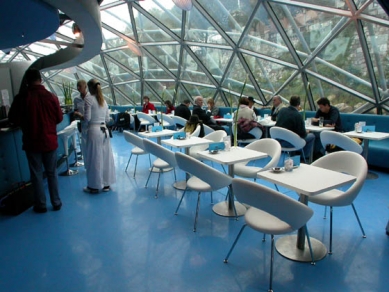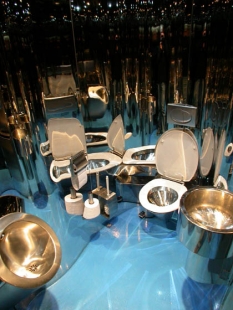
Aiola Island

Graz was "European City of Culture" in 2003. This privilege brought a number of revitalizing elements to the city's structure, which will forever remain a testament to the enlightenment of the city council. The modern layer of the 21st century has left its imprint directly on the historical core of the city. As such, the city is continuously evolving, rejuvenating, and becoming a democratic platform.
To prove Graz's cultural significance, it generously invited contemporary artists to introduce attractive elements to the city that would draw people in and become a focal point of social interest. One of the most interesting is the artificial island on the Mur River. The idea of incorporating the river, which is often associated in the minds of citizens with a barrier or potential danger, into urban life turned out to be a great success in Graz. The brainchild behind the realization of the artificial island was local native Robert Punkenhofer (Art & Idea). He also became the curator of the entire cultural event.
The conceptual plan for the island's construction saw the light of day on July 29, 1999. In October of the same year, Punkenhofer invited New York artist Vito Acconci to Graz. Acconci was, among other things, known as a collaborator of Steven Holl and as a sufficiently strong personality capable of tackling such a wild task. The project work lasted almost a year, and by the fall of 2000, Acconci, under Punkenhofer's supervision, presented the physical embodiment of his vision to the Graz city councilors. The proposal was then developed into a feasible form and approved by the city council in the spring of 2001. Work on the construction of the island began in the fall of the same year. Obtaining construction permits was not a simple matter, as building in the river was subject to river law and countless exceptions.
From November 15 to January 31, 2002, a tender for the construction contractor was held. By April, the foundation structure of the artificial island was completed. The construction work also involved the cultivation of the waterfront and immediate surroundings. The island was assembled in a factory and transported to the site by boat. Access walkways were definitively connected to the island in December 2002. The island was ceremoniously opened in January 2003. The café was completed two months later. The children's playground awaited its opening until March 2004.
The intention to build an artificial island as a place for citizens to meet is a brilliant idea. It embodies an element of sensationalism that contemporary society demands so much. Isn’t it sexy to meet your loved one in the middle of the city at a café on an island? Everything is additionally spiced up with progressive "liquid design." The original temporary installation has become a permanent structure that, unless an extremely destructive flood occurs, will offer residents and visitors of Graz an interesting experience.
The island's construction consists of three parts. Two vessel-like bowls define two basic spaces: under the domed roof is a café designed together with Acconci by the local group purpur, and in the inverted dome is an open-air theater – a mini amphitheater for cultural performances. At the point where both circular spaces meet lies a children's playground, a kind of rope-slide simulator.
The spaces are defined by a lattice shell that continuously winds through the space like a Möbius strip. The island is dominated by glass and stainless steel. From the compositional blob, two walkways shoot out connecting the island to the waterfront. Originally, the island was to be accessible by an underground corridor, but since this solution was technologically and financially demanding, two ramps won out. Personally, I think this is somewhat of a detriment. The original ephemeral sculpture of the island has been pierced by a uncompromising spear and firmly anchored the soaring idea to the ground. So instead of a water lily, the island appears more like a large knot tying both walkways together; however, the experience from the island remains strong.
The café Aiola is an excellent space. Personally, I really like derivatives of Kiesler's Endless House, and the café on the Mur, with its absence of right angles, is a brilliant representative of that. Comfortable leather seating that runs along the perimeter of the café is complemented by tables with sexy chairs. The body of the bar resembles a flower, and buzzing bees in sci-fi uniforms only enhance this impression. Over time, I felt as if I was watching Besson’s Fifth Element. You truly experience an endless space in the restrooms, which are lined with polished stainless steel (or something similar). The slightly erotic tension of the café space is further invigorated by the vibrations of the structure caused by the river's flow.
Mur Insel is proof that not all possibilities for urban development have been exhausted yet. This interesting typological type of artificial island is still a novelty in the Central European environment. Perhaps we are at the beginning of an era of river construction. The address of Mur Insel is proof of that - Mur No. 1.
One can only applaud the foresight of Punkenhofer, Acconci, and the Graz councilors. A great public space in a great city.
related links:
www.art-idea.com
www.purpur.cc
To prove Graz's cultural significance, it generously invited contemporary artists to introduce attractive elements to the city that would draw people in and become a focal point of social interest. One of the most interesting is the artificial island on the Mur River. The idea of incorporating the river, which is often associated in the minds of citizens with a barrier or potential danger, into urban life turned out to be a great success in Graz. The brainchild behind the realization of the artificial island was local native Robert Punkenhofer (Art & Idea). He also became the curator of the entire cultural event.
The conceptual plan for the island's construction saw the light of day on July 29, 1999. In October of the same year, Punkenhofer invited New York artist Vito Acconci to Graz. Acconci was, among other things, known as a collaborator of Steven Holl and as a sufficiently strong personality capable of tackling such a wild task. The project work lasted almost a year, and by the fall of 2000, Acconci, under Punkenhofer's supervision, presented the physical embodiment of his vision to the Graz city councilors. The proposal was then developed into a feasible form and approved by the city council in the spring of 2001. Work on the construction of the island began in the fall of the same year. Obtaining construction permits was not a simple matter, as building in the river was subject to river law and countless exceptions.
From November 15 to January 31, 2002, a tender for the construction contractor was held. By April, the foundation structure of the artificial island was completed. The construction work also involved the cultivation of the waterfront and immediate surroundings. The island was assembled in a factory and transported to the site by boat. Access walkways were definitively connected to the island in December 2002. The island was ceremoniously opened in January 2003. The café was completed two months later. The children's playground awaited its opening until March 2004.
The intention to build an artificial island as a place for citizens to meet is a brilliant idea. It embodies an element of sensationalism that contemporary society demands so much. Isn’t it sexy to meet your loved one in the middle of the city at a café on an island? Everything is additionally spiced up with progressive "liquid design." The original temporary installation has become a permanent structure that, unless an extremely destructive flood occurs, will offer residents and visitors of Graz an interesting experience.
The island's construction consists of three parts. Two vessel-like bowls define two basic spaces: under the domed roof is a café designed together with Acconci by the local group purpur, and in the inverted dome is an open-air theater – a mini amphitheater for cultural performances. At the point where both circular spaces meet lies a children's playground, a kind of rope-slide simulator.
The spaces are defined by a lattice shell that continuously winds through the space like a Möbius strip. The island is dominated by glass and stainless steel. From the compositional blob, two walkways shoot out connecting the island to the waterfront. Originally, the island was to be accessible by an underground corridor, but since this solution was technologically and financially demanding, two ramps won out. Personally, I think this is somewhat of a detriment. The original ephemeral sculpture of the island has been pierced by a uncompromising spear and firmly anchored the soaring idea to the ground. So instead of a water lily, the island appears more like a large knot tying both walkways together; however, the experience from the island remains strong.
The café Aiola is an excellent space. Personally, I really like derivatives of Kiesler's Endless House, and the café on the Mur, with its absence of right angles, is a brilliant representative of that. Comfortable leather seating that runs along the perimeter of the café is complemented by tables with sexy chairs. The body of the bar resembles a flower, and buzzing bees in sci-fi uniforms only enhance this impression. Over time, I felt as if I was watching Besson’s Fifth Element. You truly experience an endless space in the restrooms, which are lined with polished stainless steel (or something similar). The slightly erotic tension of the café space is further invigorated by the vibrations of the structure caused by the river's flow.
Mur Insel is proof that not all possibilities for urban development have been exhausted yet. This interesting typological type of artificial island is still a novelty in the Central European environment. Perhaps we are at the beginning of an era of river construction. The address of Mur Insel is proof of that - Mur No. 1.
One can only applaud the foresight of Punkenhofer, Acconci, and the Graz councilors. A great public space in a great city.
related links:
www.art-idea.com
www.purpur.cc
The English translation is powered by AI tool. Switch to Czech to view the original text source.
0 comments
add comment


